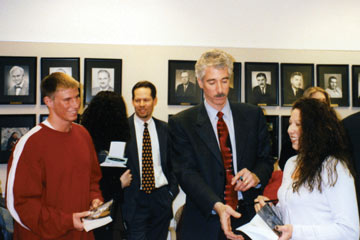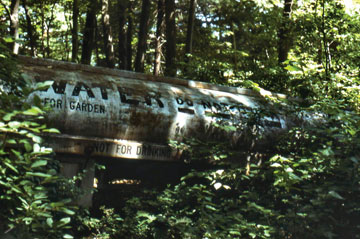|
EDUCATION & OUTREACH
Trying a Toxic Case in a Classroom
Nicole Branan
 All images courtesy of Scott Bair |
| Scott Bair's geoscience lectures at Ohio State University provide his students with the knowledge they need to develop expert opinions and testify in a mock version of the Woburn toxic trial. |
At Ohio State University, geoscience students are expert witnesses in a federal trial. Although it’s really just a mock trial, where fellow undergraduates fulfill the role of the jury and law students serve as attorneys, the case itself is real. As part of the undergraduate honors course “Science in the Courtroom,” the students reenact the Woburn Toxic Trial, the 1980s landmark case that centered around two contaminated water wells in Woburn, Mass., and spawned a best-selling book and blockbuster movie. Staging such a trial is a highly effective educational technique. “By taking on the role of an expert witness, the students use what they learned in class to solve a real-world problem,” says Scott Bair of Ohio State University in Columbus, who developed the course about 10 years ago.
In 1982, a group of eight Woburn families sued three corporations, accusing them of dumping toxic chemicals that infiltrated two city wells and contaminated the city’s water supply. The families alleged that the contamination caused the leukemia that killed five children and one adult. During the trial, expert witnesses testified to whether groundwater was flowing from the Woburn properties into the city’s water wells, and whether contaminants could have reached those wells during their operational lifetime. As a result of the 1982 case, the families received a multimillion-dollar settlement, and the area has since been named a U.S. Environmental Protection Agency Superfund site.
At Ohio State, the students prepare for their role as expert witnesses by familiarizing themselves with the trial by reading newspaper articles, trial transcripts and A Civil Action, the 1995 book that traced the entire case. “This helps students understand what the atmosphere was like surrounding the trial,” says Kevin Svitana, who worked with Bair on the project while he was a post-doctoral researcher at Ohio State. Lectures and homework assignments provide the necessary knowledge of geoscience principles. Then the students form different teams, becoming one of several experts either for the plaintiffs or the defendant. By analyzing hydrologic, geologic and chemical data from the area surrounding the wells, the students determine groundwater flow paths and calculate travel times for the different contaminants. Based on their research, they develop an expert opinion, construct trial exhibits and testify before a judge and jury.
 All images courtesy of Scott Bair |
| Ohio State students meet Jan Schlichtmann, lead attorney for the plaintiffs in the real Woburn trial. |
The process is demanding, Bair says. “Many students said they were challenged in more ways than in any other course because they had to teach the science they learned to their attorneys.” But that helps students learn how to defend their opinions with facts and how to question the opinion of others, he says. That’s an important aspect of the class, because “in our everyday lives, we are often taking facts third- and fourth-hand or we are just expressing our opinion.” That’s not possible on the witness stand. “A cross-examination is a magnificent vehicle for establishing what’s fact and what’s opinion,” he adds. The exercise also prepares students for their future because the preparation, spontaneity, teamwork and anxiety associated with the trial previews what they may face in their careers, he says.
For many students, the class is their first encounter with an actual legal case. Many of them are surprised to learn what happened in the actual trial, Bair says. All expert witnesses who testified in the Woburn trial examined the same facts but each of them interpreted them differently, he says. “That is a powerful example that illustrates that in real life there isn’t always just one answer like there is in a textbook. Instead, there is ambiguity and there are places where data is missing and where scientists have to fill in the gaps with their best professional judgment.”
Letting students experience how conflict is resolved in the U.S. legal system is also a powerful tool to teach students the scientific method, Bair says. “Both processes are actually very similar.” Scientists make observations, form a hypothesis, design experiments to test the hypothesis and then let the scientific community decide whether to accept it or not, he says. In a trial, the hypothesis is the plaintiff’s complaint, expert witnesses and attorneys gather data to support or dismantle the complaint and then the jury decides.
 All images courtesy of Scott Bair |
| A jury found for the plaintiffs in the Woburn case, which centered around whether several companies contaminated the water supply and raised cancer incidences in the Massachusetts town. |
But the course teaches students more than scientific principles. “This mock trial is a way of introducing lots of concepts not only about hydrology and geochemistry but also about the relationships between the geosciences and society,” says Cathy Manduca, director of the Science Education Resource Center at Carleton College in Northfield, Minn. Manduca collaborated with Bair in producing a Web site that describes the project and makes resources available to other teachers or to anyone who is interested in learning more about the case.
Svitana now uses the case in his classes at Otterbein College in Westerville, Ohio. “I am using this case to teach students not just the science but also how it integrates with society.” The case is ideal for exploring the interface between science, citizen action, public health and the U.S. legal system, he says.
Bair’s classes usually include a wide variety of students, including both geoscience majors as well as non-science majors. The class has broad appeal because it involves so many different aspects, he says. For example, history majors usually get interested in the actual trial procedure, while pre-med students are often more interested in the leukemia aspect. Learning how a toxic compound in the water supply becomes a toxicological problem in a human intrigues geoscience and engineering majors.
And because the case involves human emotion, students often get very engaged, Bair says. “It all centers around the health of a small neighborhood in a small town. And the residents could be any of us,” he says. And because a mock trial involves role-playing, students tend to get emotionally involved and take ownership of their characters, Svitana adds. Manduca agrees: “A mock trial is an exciting way of engaging students and all of the research shows that when students are engaged in learning, they learn more.”
For more information about the Science in the Courtroom Woburn Toxic Trial Project, or to use it in your own class, visit: http://serc.carleton.edu/woburn.
Links:
Science in the Courtroom Woburn Toxic Trial Project

 Subscribe
Subscribe


